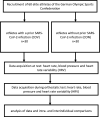Effects of Covid-19 on the autonomic nervous system in elite athletes assessed by heart rate variability
- PMID: 37360977
- PMCID: PMC10191822
- DOI: 10.1007/s11332-023-01067-7
Effects of Covid-19 on the autonomic nervous system in elite athletes assessed by heart rate variability
Abstract
Introduction: Covid-19 is a viral airway and systemic infection which can negatively affect the function of the autonomic nervous system. Cardiovascular autonomic function is essential for peak athletic performance. The aim of this study was to assess the effects of a Covid-19 disease on the autonomic nervous system of German elite athletes using heart rate variability (HRV).
Methods: 60 elite athletes (aged 22.88 ± 4.71 years) were recruited, 30 of whom had undergone a Covid-19 disease. Heart rate (HR), blood pressure (BP) and heart rate variability (HRV) were measured during rest and during an orthostatic challenge.
Results: At rest and after orthostatic stress blood pressure and the root mean square of successive differences (RMSDD) were significantly lower in Covid-19 athletes (COV) than in control athletes (CON) (p = 0.002 and p = 0.004, respectively); heart rate was significantly higher (p = 0.001). COV showed a significantly greater reduction in blood pressure and elevation of heart rate than CON, but the change in RMSSD did not differ significantly during the orthostatic challenge.
Conclusion: These results show a change in cardiac parasympathetic activity and cardiovascular autonomic function in German elite athletes after Covid-19. These findings further the understanding of effects of the Covid-19 disease on the cardiovascular physiology in athletes. Heart rate variability may be a helpful tool in the return-to-play assessment of elite athletes.
Supplementary information: The online version contains supplementary material available at 10.1007/s11332-023-01067-7.
Keywords: Athletes; Autonomic nervous system; Blood pressure; Covid-19; Heart rate; Heart rate variability.
© The Author(s) 2023.
Conflict of interest statement
Conflict of interestNone of the authors has any conflict of interest to report. The results of this study are presented clearly, honestly, and without fabrication, falsification, or inappropriate data manipulation.
Figures




Similar articles
-
Comparative Analysis of Heart Rate Variability and Arterial Stiffness in Elite Male Athletes after COVID-19.J Clin Med. 2024 Oct 8;13(19):5990. doi: 10.3390/jcm13195990. J Clin Med. 2024. PMID: 39408050 Free PMC article.
-
Precompetitive assessment of heart rate variability in elite female athletes during play offs.Clin Physiol Funct Imaging. 2014 May;34(3):230-6. doi: 10.1111/cpf.12088. Epub 2013 Oct 1. Clin Physiol Funct Imaging. 2014. PMID: 24112387
-
Utilizing Heart Rate Variability for Coaching Athletes During and After Viral Infection: A Case Report in an Elite Endurance Athlete.Front Sports Act Living. 2021 Sep 3;3:612782. doi: 10.3389/fspor.2021.612782. eCollection 2021. Front Sports Act Living. 2021. PMID: 34541520 Free PMC article.
-
Heart rate-based indices to detect parasympathetic hyperactivity in functionally overreached athletes. A meta-analysis.Scand J Med Sci Sports. 2021 Jun;31(6):1164-1182. doi: 10.1111/sms.13932. Epub 2021 Mar 4. Scand J Med Sci Sports. 2021. PMID: 33533045
-
Heart rate variability in athletes.Sports Med. 2003;33(12):889-919. doi: 10.2165/00007256-200333120-00003. Sports Med. 2003. PMID: 12974657 Review.
Cited by
-
Comparative Analysis of Heart Rate Variability and Arterial Stiffness in Elite Male Athletes after COVID-19.J Clin Med. 2024 Oct 8;13(19):5990. doi: 10.3390/jcm13195990. J Clin Med. 2024. PMID: 39408050 Free PMC article.
-
Heart Rate Variability Applications in Medical Specialties: A Narrative Review.Appl Psychophysiol Biofeedback. 2025 Sep;50(3):359-381. doi: 10.1007/s10484-025-09708-y. Appl Psychophysiol Biofeedback. 2025. PMID: 40293647 Review.
References
-
- Sachs JD, Karim SSA, Aknin L, Allen J, Brosbøl K, Colombo F, Barron GC, Espinosa MF, Gaspar V, Gaviria A, Haines A, Hotez PJ, Koundouri P, Bascuñán FL, Lee J-K, Pate MA, Ramos G, Reddy KS, Serageldin I, Thwaites J, Vike-Freiberga V, Wang C, Were MK, Xue L, Bahadur C, Bottazzi ME, Bullen C, Laryea-Adjei G, Amor YB, Karadag O, Lafortune G, Torres E, Barredo L, Bartels JGE, Joshi N, Hellard M, Huynh UK, Khandelwal S, Lazarus JV, Michie S. The lancet commission on lessons for the future from the COVID-19 pandemic. Lancet (London, England) 2022;400:1224–1280. doi: 10.1016/S0140-6736(22)01585-9. - DOI - PMC - PubMed
-
- Huang C, Wang Y, Li X, Ren L, Zhao J, Hu Y, Zhang L, Fan G, Xu J, Gu X, Cheng Z, Yu T, Xia J, Wei Y, Wu W, Xie X, Yin W, Li H, Liu M, Xiao Y, Gao H, Guo L, Xie J, Wang G, Jiang R, Gao Z, Jin Q, Wang J, Cao B. Clinical features of patients infected with, novel coronavirus in Wuhan, China. The Lancet. 2019;395(2020):497–506. doi: 10.1016/S0140-6736(20)30183-5. - DOI - PMC - PubMed
-
- Dergaa I, Ammar A, Souissi A, Fessi MS, Trabelsi K, Glenn JM, Ghram A, Taheri M, Irandoust K, Chtourou H, Romdhani M, Ben Saad H, Chamari K. COVID-19 lockdown Impairments of objective measurements of selected physical activity, cardiorespiratory and sleep parameters in trained fitness coaches. EXCLI J. 2022;21:1084–1098. doi: 10.17179/excli2022-4986. - DOI - PMC - PubMed
LinkOut - more resources
Full Text Sources
